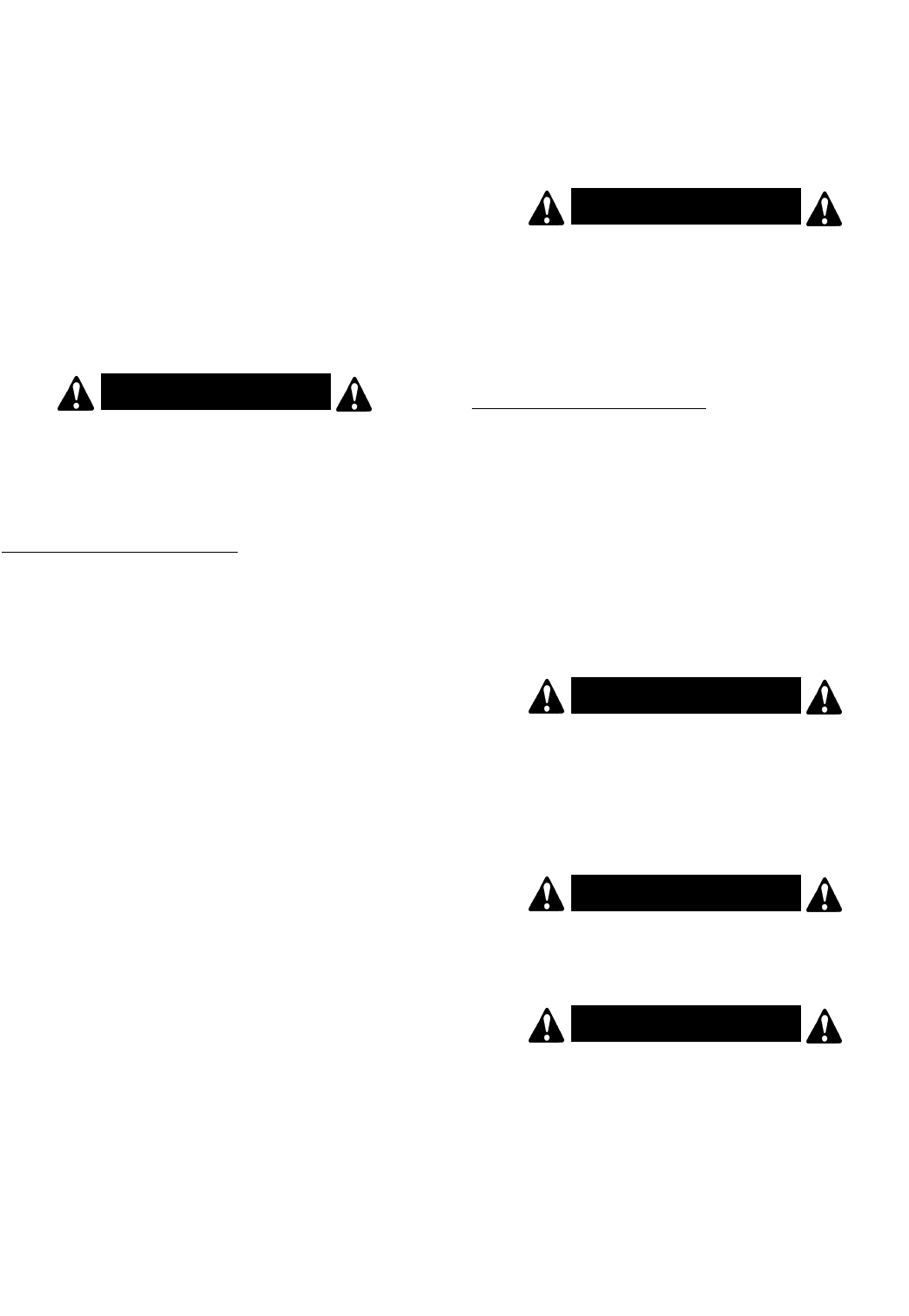
1316
SAFETY SIGNS
WARNING
Always insert spears in
bale – never
under bale.
Failure to do this can allow bale
roll back when loader is raised,
causing serious injury or death.
101127
(For models JDBS-423, JDBS-434, JDBS-433,
JDBS-623, JDBS-633 and JDBS-634)
(For models JDBS-412, JDBS-423, JDBS-434
and JDBS-433)
REMEMBER:
If Safety Signs have been damaged, removed, become
illegible or parts replaced without Signs, new Safety Signs
must be applied. New Safety Signs are available from your
authorized distributor or factory.
BE CAREFUL!
Use a clean, damp cloth to clean safety decals. Avoid
spraying to close to decals when using a pressure washer;
high-pressure water can enter through very small scratches
or under edges of decals causing them to peel or come off.
INSTRUCTIONS (continued)
OPERATION (continued)
——————————————————
NOTE: In cold weather, a bale frozen to the ground may
exceed the lifting capacity of spear and loader. Damage
to spear or loader may occur. Not covered under
warranty.
NOTE: Soft center bales will tend to droop after being
lifted by a single spear. Placing the spear in a lower
position in the bale will allow for more lifting height and
lessen the load on the stabilizer spears.
WARNING!
■ Never exceed the lift capacity of the tractor-loader
used with the spear attachment.
■ A heavy load can cause instability in driving a
tractor. Make sure the rear of the tractor is properly
counter-balanced with weights or a bale. Always
drive slowly – especially around turns. An unstable
tractor could steer badly and possibly tip over,
causing injury or death.
CAUTION!
Beware of lift clearance when raising loader to max-
imum height.
HANDLING ALL BALES:
When stacking bales, ALWAYS MAKE SURE BALES
ARE PLACED SO THE STACK IS STABLE.
Keep all bystanders at a safe distance. REMEMBER –
FALLING BALES CAN ROLL OR TUMBLE.
When stacking hay bales or loading vehicles, make
sure you are operating in an area AWAY FROM OVER-
HEAD WIRES.
NOTE: In cold weather, a bale frozen to the ground may
exceed the lifting capacity of spear and loader. Damage
to spear or loader may occur. Not covered under
warranty.
DANGER!
Beware of low electrical wires when loader is
raised. Serious injury or death can result if contact is
made.
Do not leave the operator’s seat if any part of the
tractor or implement contacts electric lines.
CAUTION!
NEVER LET ANYONE CLIMB ON STACKED ROUND
HAY BALES!
RECT
ANGULAR BALES:
Using the bucket tilt cylinders, adjust the angle of the
spear(s) so they are parallel with the center of the hay
bale. Center the spears with the width of the bale.
With the power unit, push the spear(s) into the large
hay bale. Make sure you have penetrated the hay bale far
enough so the bale doesn’t want to come off the end of
the spear(s). If, when you initially pick the bale up, it tends
to droop forward, this would indicate you have not pene-
trated the bale far enough.
Tilt the ends of the spear(s) upward (about 15-20
degrees) when transporting the hay bales. This will
reduce any tendency for the bale to slide off the spear(s)
while being transported.
When you have placed the hay bale in the desired loca-
tion, it is recommended to tilt the spear ends slightly
downward (5-7 degrees) so as you pull away from the
bale it will slide off the spear(s) more easily. Different
location and circumstances will determine the best with-
draw angle to use.
NOTE: Optional bolt-on uprights are available to trans-
port two rectangular bales at a time (see page 27). Order
#831095 (one pair of uprights).
NOTE: Always make sure bale spear fully penetrates the
bale. Partial penetration locates all the weight of the bale
on the outer end and can damage spear.
WARNING!
NEVER try to handle two rectangular bales at once
without the 831095 optional bolt-on uprights
installed. Failure to use the uprights can allow the
top bale to roll back when loader is raised, causing
serious injury or death.


















